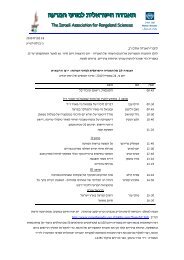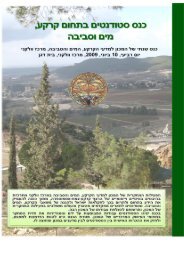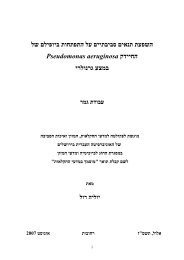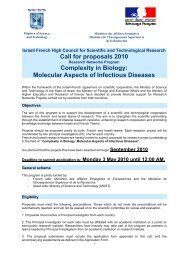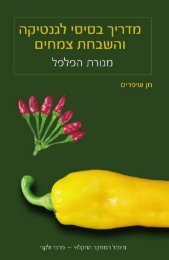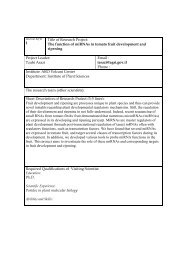Ghanim et al 1998 - Virology .pdf
Ghanim et al 1998 - Virology .pdf
Ghanim et al 1998 - Virology .pdf
Create successful ePaper yourself
Turn your PDF publications into a flip-book with our unique Google optimized e-Paper software.
302 GHANIM ET AL.V61 (nt 61–80, vir<strong>al</strong> strand, 5ATACTTGGACACCTAAT-GGC3) and C473 (nt 473–457, complementary strand,5AGTCACGGGCCCTTACA3). Oligonucleotides werepurchased from Biotechnology Gener<strong>al</strong> (Rehovot, Israel).The cycling protocol (using a Techne PHC-2 thermocycler)was as follows: initi<strong>al</strong> denaturation for 3 min at95°C, anne<strong>al</strong>ing of primers for 1 min at 45°C, addition of1 unit of TaqI polymerase, extension for 2 min at 72°C,and denaturation for 1 min at 94°C; subsequent cycleswere: 1 min at 45°C, 2 min at 72°C, and 1 min at 94°C;after 30 cycles, the reaction was terminated by a 10 minincubation at 72°C (Navot <strong>et</strong> <strong>al</strong>., 1992). The PCR productswere subjected to electrophoresis in a 1% agarose geland were photographed. The amplified virus DNA wasidentified after blotting and hybridization with radiolabeledplasmid pTYH19 containing a full-length copy ofthe TYLCV genome (Navot <strong>et</strong> <strong>al</strong>., 1991). Autoradiographywasfor1to5h.D<strong>et</strong>ection of TYLCV DNA in plants and in insects bysquash blot and Southern blot hybridizationSquashes of tomato leaves were prepared and hybridizedwith a radiolabeled DNA probe as described previously(Navot <strong>et</strong> <strong>al</strong>., 1989). Tot<strong>al</strong> DNA extracted from tomatoplants and from insects (egg, instar, and adult) was hybridizedwith radiolabeled plasmid pTYH19 as described (Czosnek<strong>et</strong> <strong>al</strong>., 1988b; Zeidan and Czosnek, 1991).Dissection of ovaries and maturing eggs of B. tabaciand observation in the scanning electron microscopeInsects were kept on the microscope cylindric<strong>al</strong> mountusing double-sided adhesive tape. The abdomen wasseparated from the thorax and pressing the tip of theabdomen expelled its content. The intern<strong>al</strong> organs werewashed sever<strong>al</strong> times with water using a Pasteur pip<strong>et</strong>tewith a narrow tip, and the ovaries were separated fromthe other organs. For PCR an<strong>al</strong>ysis, DNA was extractedas described above. For microscope observation, th<strong>et</strong>issues were processed essenti<strong>al</strong>ly as described by Nation(1983), omitting the treatment with hexam<strong>et</strong>hyldisilazane.Ovaries were fixed by immersing the tissues in0.2% glutar<strong>al</strong>dehyde, 4% paraform<strong>al</strong>dehyde in PBS for 5min. The tissues were then flushed two to three timeswith sterile distilled water and <strong>al</strong>lowed to air dry. Thesamples were observed in a JOEL 5410 LV scanningelectron microscope at low vacuum.Oviposition on artifici<strong>al</strong> mediumViruliferous insects were placed in a 5-ml glass vi<strong>al</strong>(one insect per vi<strong>al</strong>). The vi<strong>al</strong> was covered with a layer ofKimwipes held in place with a layer of str<strong>et</strong>ched Parafilmmembrane (the paper <strong>al</strong>lowed the eggs to stick). About0.5 ml LB medium containing 15% sucrose was depositedon the membrane and covered with a second layerof str<strong>et</strong>ched Parafilm membrane.ACKNOWLEDGMENTSThis work was supported by Grant 95-168 from The US-Israel Bination<strong>al</strong>Science Foundation. M.Z. was recipient of The Golda Meir FellowshipFund.REFERENCESAl-Musa, A. (1982). Incidence, economic importance, and control oftomato yellow leaf curl in Jordan. Plant Dis. 66, 561–563.Black, L. M. (1950). A plant virus that multiplies in its insect vector.Nature 166, 852–853.Black, L. M. (1953). Occasion<strong>al</strong> transmission of some plant virusesthrough the eggs of their insect vectors. Phytopathology 43, 9–10.Caciagli, P., Bosco, D., and Al-Bitar, L. (1995). Relationships of theSardinian isolate of tomato yellow leaf curl geminivirus with itswhitefly vector Bemisia tabaci Gen. Eur. J. Plant Pathol. 101, 163–170.Caciagli, P., and Bosco, D. (1997). Quantitation over time of tomatoyellow leaf curl geminivirus DNA in its whitefly vector. Phytopathology87, 610–613.Cohen, S., and Harpaz, I. (1964). Periodic, rather than continu<strong>al</strong>, acquisitionof a new tomato virus by its vector, the tobacco whitefly(Bemisia tabaci Gennadius). Ent. Exp. Appl. 7, 155–166.Cohen, S., and Nitzany, F. E. (1966). Transmission and host range of th<strong>et</strong>omato yellow leaf curl virus. Phytopathology 56, 1127–1131.Cohen, S., Kern, J., Harpaz, I., and Ben-Joseph, R. (1988). Epidemiologic<strong>al</strong>studies of the tomato yellow leaf curl virus (TYLCV) in the JordanV<strong>al</strong>ley, Israel. Phytoparasitica 16, 259–270.Cohen, S. (1993). Swe<strong>et</strong> potato whitefly biotypes and their connectionwith squash silver leaf. Phytoparasitica 21, 174.Costa, H. S., Toscano, N. C., and Henneberry, T. J. (1996a). Myc<strong>et</strong>ocyteinclusion in the oocytes of Bemisia argentifollii (Homoptera: Aleyrodidae).Ann. Entomol. Soc. Am. 89, 694–699.Costa, H. S., Westcot, D. M., Ullman, D. E., Rodell, R. C., Brown, J. K., andJohnson, M. W. (1996b). Virus-like particles in the myc<strong>et</strong>ocyte of theswe<strong>et</strong>potato whitefly, Bemisia tabaci (Homoptera, Aleyrodidae). J. Invert.Pathol. 67, 183–186.Czosnek, H., Ber, R., Antignus, Y., Cohen, S., Navot, N., and Zamir, D.(1988a). Isolation of the tomato yellow leaf curl virus—A geminivirus.Phytopathology 78, 508–512.Czosnek, H., Ber, R., Navot, N., Zamir, D., Antignus, Y., and Cohen, S.(1988b). D<strong>et</strong>ection of tomato yellow leaf curl virus in lysates of plantsand insects by hybridization with a vir<strong>al</strong> DNA probe. Plant Dis. 72,949–951.Czosnek, H., and Laterrot, H. (1997). A worldwide survey of tomatoyellow leaf curl viruses. Arch. Virol. 142, 1391–1406.Duffus, J. E. (1963). Possible multiplication in the aphid vector ofsowthistle yellow vein virus, a virus with an extremely long insectlatent period. <strong>Virology</strong> 21, 194–202.Duffus, J. E. (1987). Whitefly transmission of plant viruses. In ‘‘CurrentTopics in Vector Research’’ (K. F. Harris, Ed.), Vol. 4, pp. 73–91.Springer-Verlag, Berlin.Fukushi, T. (1933). Transmission of the virus through the eggs of aninsect vector. Proc. Imp. Acad. (Tokyo) 9, 457–460.Fukushi, T. (1935). Multiplication of virus in its vector. Proc. Imp. Acad.(Tokyo) 11, 801–303.Grylls, N. E. (1954). Rugose leaf curl—A new virus disease transovari<strong>al</strong>lytransmitted by the leafhopper Austroag<strong>al</strong>lia torrida. Austr<strong>al</strong>ian.J. Biol. Sci. 7, 47–58.Harris, K. F., Pesic-Van Esbroeck, Z., and Duffus, J. E. (1995). Anatomy ofa virus vector. In ‘‘Bemisia 1995: Taxonomy, Biology, Damage, Controland Management’’ (D. Gerling and R. Mayer, Eds.), pp. 289–318.Intercept, Buckinghamshire, UK.Harrison, B. D. (1985). Advances in geminivirus research. Annu. Rev.Phytopathol. 23, 55–82.Jancovich, J. K., Davidson, E. W., Lavine, M., and Hendrix, D. L. (1997).Feeding chamber and di<strong>et</strong> for culture of nymph<strong>al</strong> Bemisia argentifolii(Homoptera: Aleyrodidae). J. Econom. Entomol. 90, 628–633.




